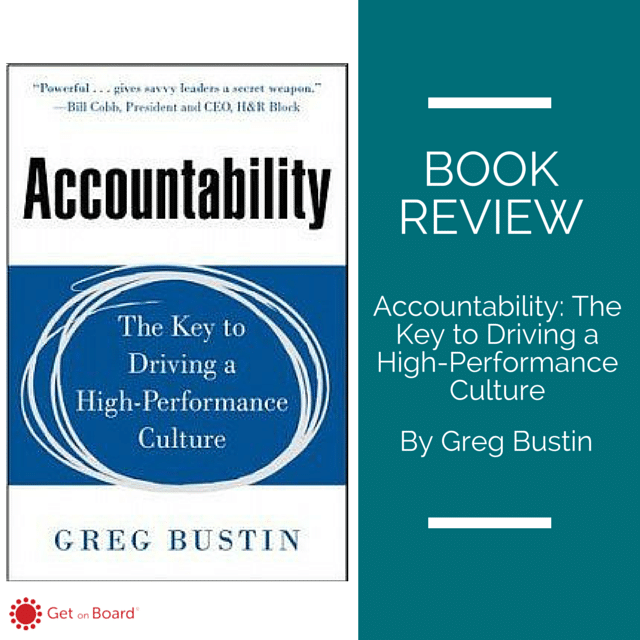Book Review: Accountability. The Key to Driving a High-Performance Culture by Greg Bustin

“Lack of accountability is the single greatest obstacle facing even the most experienced leaders. It saps morale, drains profit, and disenfranchises employees – and it can shift your team into crisis mode on a daily basis.”
As I read this book, I was reminded of the saying “the fish rots from the head”. It refers to an organisation’s shortcomings and downfalls usually stemming from problems at the head of the business – the board.
And Bustin is quick to remind us why the board is so important in setting an agenda of accountability – “your plan [to achieving the organisation’s vision] is your road map… without a plan, expectations are not clear. And without clear expectations, accountability is not possible.”
With one of the primary roles of a board being input into and signing-off of the strategic plan, you can understand why this book makes for mandatory director reading.
Another reason why this book is a worthwhile investment is that it is great for anyone who is leading and/or managing people. The book is written from the perspective of senior leaders using real-life situations, and is laid-out in a style that provides you with seven guideposts to creating an accountability culture. Furthermore, Bustin includes a comprehensive appendix that supplies you with templates, self-assessments, and resources referenced in the book for you to utilise within your organisation.
Personal Impact
Like many of you, I have experienced the impacts of a weak accountability culture, both in workplaces and on boards. In fact, I was compelled to read this book during the midst of an accountability crisis on one of my boards. The problem was largely due to one director; however, because an accountability culture was never instilled or fostered, everyone suffered and we were all responsible for the resulting unproductive and uncomfortable environment.
To turn around this negative atmosphere, we all needed to be on the same page with all of us working toward an agreed-upon culture and environment that was conducive to achieving the strategic outcomes of the board and the business.
Serendipitous Discovery
I came across Greg Bustin’s (@GregBustin) work via The Executive Connection. This gave me the tick of approval that his work was worth paying attention to.
When he visited Adelaide in mid-2014, my husband received this book from him; and me being in the midst of the board situation mentioned above took this as a sign that now was the time to read Greg’s book.
Greg’s approach to building an accountability culture takes on the analogy of pillars holding up a bridge. Seven to be exact. This bridge analogy symbolises the interdependence of each pillar of accountability. Each pillar, Greg says, is a crucial part of effective leadership.
The Take-Home
The seven pillars include Character, Unity, Learning, Tracking, Urgency, Reputation, and Evolution. In the interest of brevity, I have picked out two pillars that resonated most with me personally and made sense at a board level.
Unity
Every employee knows and supports the organisation’s mission, vision, values, and strategy, and knows their role in helping to achieve them. To me this is reminiscent of Jim Collins’ Good to Great analogy of having everyone on the same carriage heading in the same direction.
This chapter advocates that having a clear purpose and plan, that is consistently communicated, forges solidarity, inspires confidence, and drives performance. Bustin reminds us that over communication does not exist in regard to reinforcing the purpose and plan. He also recommends communicating both the positive and negative consequences of achieving the goals of the business, and following through.
Spending some time galvanising the other directors on the mission to change the culture of the board was incredibly effective and lead to the positive outcome that we were hoping for. It’s only the beginning, but it was an extremely positive start. Our carriage was now full of people who were all heading in the same direction.
Learning
Being the CEO of a learning and development organisation this pillar certainly resonated with me. I am a firm believer of continuous learning and improvement. I am constantly asking, “What’s working? What’s not? And how can we be better, more efficient and more effective?”
Bustin tells us that this constant questioning is the mindset of top performers. Do your fellow board members think like this? Does your CEO have this mindset? Asking “How can we do this better” is a great way of challenging and developing talent, and reinforcing unity.
To me, learning extends to reviewing the performance and effectiveness of individual directors and the board as a whole. Conducted regularly, this assessment enables high performance due to consistently addressing the gaps and shortcomings in knowledge, skills, and abilities on the board.
If you are looking to build and sustain an environment of accountability on your board and within your organisation, Accountability by Greg Bustin is a worthwhile addition to your director library. It’s 7-pillar approach and plethora of resources gives you a nice head start on leading a sustained culture change.
